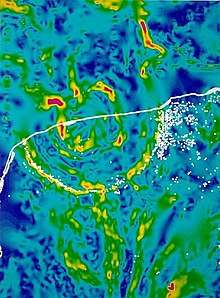Chicxulub impactor
The Chicxulub impactor (/ˈtʃiːkʃəluːb/ CHEEK-shə-loob), also known as the K/Pg impactor and (more speculatively) as the Chicxulub asteroid, was an asteroid or other celestial body some 11 to 81 kilometres (7 to 50 mi) in diameter and having a mass between 1.0×1015 and 4.6×1017 kg,[3] which struck the Earth at a velocity of roughly 20 kilometers per second[4] at an angle of just under 60 degrees[5] (although originally thought to be shallower)[6] at the end of the Cretaceous period, 66 million years ago,[7] creating the Chicxulub crater. It impacted a few kilometres from the present-day town of Chicxulub in Mexico, after which the impactor and its crater are named. Because the estimated date of the object's impact and the Cretaceous–Paleogene boundary (K–Pg boundary) coincide, there is a scientific consensus that its impact was the Cretaceous–Paleogene extinction event which caused the death of the planet's non-avian dinosaurs and many other species.[8][9] In October 2019, researchers reported that the event rapidly acidified the oceans producing ecological collapse and long-lasting effects on the climate, and, accordingly, was a key reason for the Cretaceous–Paleogene extinction event.[10][11]

The impactor's crater is over 150 kilometres (93 miles) in diameter[12] making it one of the largest known impact craters on Earth.
Parent body
Several competing models for the impactor's origin exist, and for its relationship to other asteroids that continue to exist in the Solar System. In September 2007, William F. Bottke, David Vokrouhlický, and David Nesvorný proposed an origin for the impactor in an article published in Nature. They argued that a collision in the asteroid belt 160 million years ago resulted in the Baptistina family of asteroids, the largest surviving member of which is 298 Baptistina. They proposed that the Chicxulub impactor was an asteroid member of this group, referring to the large amount of carbonaceous material present in microscopic fragments at the site, suggesting that it was a member of a rare class of asteroids called carbonaceous chondrites, like Baptistina. According to Bottke, the Chicxulub impactor was a fragment of a much larger parent body about 170 km (110 mi) across, with the impacting body being around 6 km (4 mi) in diameter.
However, in 2011 new data from the Wide-field Infrared Survey Explorer revised the date of the collision which created the Baptistina family to about 80 million years ago, casting doubt on the hypothesis, as typically the process of resonance and collision of an asteroid takes many tens of millions of years.[13]
Other work has associated the asteroid P/2010 A2, a member of the Flora family of asteroids, as a possible remnant cohort of the Chicxulub impactor.[14]
References
- Nicholas M. Short, Sr., Crater Morphology Some Characteristic Impact Structures Archived 2012-02-04 at the Wayback Machine at nasa.gov, accessed January 2013
- The article by Nicholas M. Short, Sr. appears to have moved, but the image above does not appear to have moved with it. See Crater Morphology Some Characteristic Impact Structures at fas.org, Accessed December 9, 2015.
- Durand-Manterola, H. J.; Cordero-Tercero, G. (2014). "Assessments of the energy, mass and size of the Chicxulub Impactor". arXiv:1403.6391 [astro-ph.EP].
- Asteroid terminated dinosaur era in a matter of days. National Geographic. March 4, 2010.
- Collins, G.S., Patel, N., Davison, T.M. et al. A steeply-inclined trajectory for the Chicxulub impact. Nat Commun 11, 1480 (2020). https://doi.org/10.1038/s41467-020-15269-x
- Broad, William J. (26 November 1996). "Asteroid's Shallow Angle May Have Sent Inferno Over Northern Kill Zone". The New York Times. Retrieved 27 May 2020.
- "Dinosaur extinction: Scientists estimate 'most accurate' date". BBC News. 2013-02-08. Retrieved 2015-10-28.
- "International Consensus — Link Between Asteroid Impact and Mass Extinction Is Rock Solid". www.lpi.usra.edu. Retrieved 2015-10-28.
- Schulte, Peter (March 5, 2010). "The Chicxulub Asteroid Impact and Mass Extinction at the Cretaceous-Paleogene Boundary" (PDF). Science. 327 (5970): 1214–8. Bibcode:2010Sci...327.1214S. doi:10.1126/science.1177265. PMID 20203042. Archived from the original (PDF) on June 25, 2015. Retrieved 2015-06-25.
- Joel, Lucas (21 October 2019). "The Dinosaur-Killing Asteroid Acidified the Ocean in a Flash - The Chicxulub event was as damaging to life in the oceans as it was to creatures on land, a study shows". The New York Times. Retrieved 22 October 2019.
- Henehan, Michael J.; et al. (21 October 2019). "Rapid ocean acidification and protracted Earth system recovery followed the end-Cretaceous Chicxulub impact". Proceedings of the National Academy of Sciences of the United States of America. 116 (45): 22500–22504. Bibcode:2019PNAS..11622500H. doi:10.1073/pnas.1905989116. PMC 6842625. PMID 31636204.
- "Chicxulub". Earth Impact Database. Planetary and Space Science Centre University of New Brunswick Fredericton. Retrieved December 30, 2008.
- Tammy Plotner, Did Asteroid Baptistina Kill the Dinosaurs? Think other WISE... in Universe Today (2011) at universetoday.com
- "Smashed asteroids may be related to dinosaur killer" Reuters, February 2, 2010

